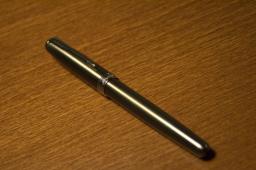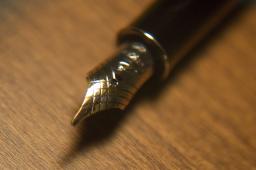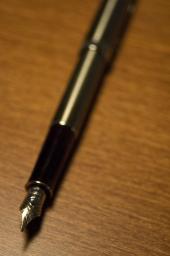
Meet The Parkers, Part II
 Regular readers of Monochromatic Outlook will recall that I’ve recently written a bit about the lower-end Parker fountain pens that hold such a dear place in my heart. By coincidence, my studio partner asked if I would look at the pen I gave her as a gift a couple of years ago. It has been skipping and she’s been having trouble getting it started. I wrote recently that every pen I’d ever given as a gift was a Waterman, but I misremembered. I gave her a Parker Sonnet in verdigris. I must really like her, as I’ve never gotten myself a pen this nice!
Regular readers of Monochromatic Outlook will recall that I’ve recently written a bit about the lower-end Parker fountain pens that hold such a dear place in my heart. By coincidence, my studio partner asked if I would look at the pen I gave her as a gift a couple of years ago. It has been skipping and she’s been having trouble getting it started. I wrote recently that every pen I’d ever given as a gift was a Waterman, but I misremembered. I gave her a Parker Sonnet in verdigris. I must really like her, as I’ve never gotten myself a pen this nice!
 The nib is 18kt gold with a distinctive but unobtrusive criss-cross pattern of white and yellow gold.
The nib is 18kt gold with a distinctive but unobtrusive criss-cross pattern of white and yellow gold.
Although «nice» really only applies to pens that write reliably. This Sonnet had some issues with inkflow. I cleaned and recleaned, but couldn’t get it to write without applying more pressure than I should have to. I was crestfallen.
This turned to fear as I looked at Parker’s website for warranty information. I remembered Parkers having a lifetime warranty, but the terms have changed and now new Parkers come with a two-year warranty. Since this was given as a gift at Christmastime in 2004, the pen would be just outside of the window.
I phoned Parker’s service line and received a call back from a very helpful woman who told me to send it in with the warranty card and that they would take care of it. She said probably there would be no charge, but if they had to charge me for any repairs that they would call me first. This put my mind at ease and I retrieved the warranty card from Vikki and, once the shipping tube arrived, I sent it to Parker. A week later, it arrived back. They’d replaced the feed, done a write test and a complete check (actions itemized on the packing slip) and sent it back to me without even asking me to pay for shipping. I sent it on a Monday by third-day UPS, the packing slip is dated that Thursday and I received it back at my mailbox the following Monday. I’m pretty impressed that the folks at the Parker service center didn’t dawdle a bit.
 Having gotten it back, of course I did some writing with it. Now, it can be called nice without reservation. While I noticed the slightest hesitation in starting, that’s a shortcoming of many pens and one I can forgive when the hesitation does not continue. While the first stroke each time I sat down with the Sonnet was dry, the ink flowed from then on without so much as a single skip. I liken it to a car’s motor starting on the second cycle of the starter motor. In practice, you’d never give it a second thought. My Triumph starts consistently on the fifth cycle, every time. Yin-yin-yin-yin-VROOM! Nothing wrong with it, it just takes that long to catch.
Having gotten it back, of course I did some writing with it. Now, it can be called nice without reservation. While I noticed the slightest hesitation in starting, that’s a shortcoming of many pens and one I can forgive when the hesitation does not continue. While the first stroke each time I sat down with the Sonnet was dry, the ink flowed from then on without so much as a single skip. I liken it to a car’s motor starting on the second cycle of the starter motor. In practice, you’d never give it a second thought. My Triumph starts consistently on the fifth cycle, every time. Yin-yin-yin-yin-VROOM! Nothing wrong with it, it just takes that long to catch.
I’ve since surrendered the Sonnet to its owner, who reports that it never has a slow start for her. Whether that means that my experience with it was an artifact of a freshly-filled pen or proof of my theory that a half stroke to start is beneath notice I don’t know, but I’m happy that she is pleased with the pen’s performance.
The feel of the Sonnet is delightful. Of course, it’s a matter of personal preference. I tend to like my pens either stiffer or more flexible than the Sonnet’s. That’s specific to the modes of my writing or drawing; either I want to have the control over the width of the line by varying the pressure, in which case I want as much variability as possible, or I want a clean line with no variation at all. I’m generally a Rapidograph and brush man and don’t care much for pens that are in-between.
With that said, sometimes a generally stuff nib will surprise me with subtlety and finesse. My Rotring 700 is a great example. It puts down a very clean, consistent line, but when I write with it, sometimes the most delightful variations will emerge. Therefore, despite my preference for extremes, there is a lot to be said for the middle ground, especially for a person who may only ever own one fine pen in their life.
Parker made this pen just for that person: the person that isn’t going to get so obsessed with fountain pens as to start collecting but who will instead treasure this one pen and appreciate its nuances and quirks. It’s an accessible pen, easy to use, smooth and reliable. It’s got a nice medium weight to it, although enough to preclude it from the school of thought that a pen should disappear and not be noticed in your hand. I never subscribed to that school anyhow. I tend more toward a 40 or even 50 gram pen being ideal, but even 15 or 20 grams is enough to enjoy the weight in my hand. The Sonnet is well above that range.
While this pen is a very smooth writer and its manufacture of excellent quality and materials, its characteristics are largely middle-of the road choices that will not please the collector or jaded aficionado who is looking for things unseen before. For someone who wants an excellent yet unpretentious pen to bring refinement and pleasure to the mechanics of writing, the Parker Sonnet will likely fill the bill.
Parker Sonnet: filled weight 28 grams